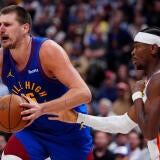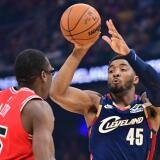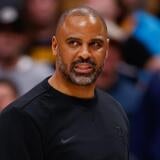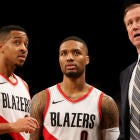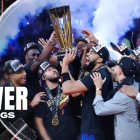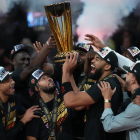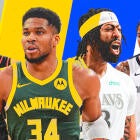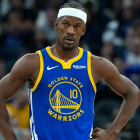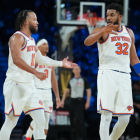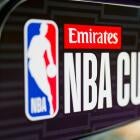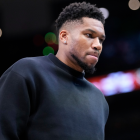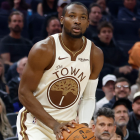
Blazers' core question: Has Damian Lillard-CJ McCollum pairing already peaked?
Portland is good enough now, but how does it go from here to great, and what will it take to get there?

The Trail Blazers are the opposite of what they were a season ago.
I'm not kidding. Even though Portland changed zero rotation players except for Shabazz Napier while trading Allen Crabbe, it has inverted its very identity. Last season, Portland spent most of the season as a bottom-five defensive team. The late addition of Jusuf Nurkic pushed it to 21st. This season? Portland features the fourth-best defensive rating so far.
Last season, the Blazers were a dynamo offensively, finishing 11th in offensive rating. This season? They rank 22nd. Their offense, outside of Damian Lillard and CJ McCollum, is pitiful. They made strides in their key area of weakness -- defense -- and have significantly stepped back in terms of offense.
Now, despite the Blazers not having made any significant changes in terms of personnel over the summer, there is, of course, the addition of Nurkic to account for. While Nurkic was with Portland last season, it was 11th in defense and actually improved offensively to fourth. So it stands to reason that the push this season defensively for Portland has most to do with Nurkic, and that the Blazers' offensive issues are to do with the other players, particularly the lack of shooting.
But there's a more complicated story under the hood of their bandwagon, and it's one that could have big impacts on their future. Are the Blazers working with a roster and Big 3 that can only get better, or is a big move in order?
The Core
The future of the Blazers, for the moment, is built around Lillard, McCollum and Nurkic. Let's look at some collected separate thoughts and facts about them and then we can circle it back.
- Damian Lillard isn't having a tremendous season. He's below last season in points per game and per 100 possessions, and is shooting a career-worst 33 percent from deep. However, the team has been a plus-3.7 in net rating, vs. a minus-1.3 when he's on the bench, the best of any Blazers except Al-Farouq Aminu (who missed several games with injury.) Lillard's defense this season has been very quietly ... good. Not just "fine" like Russell Westbrook and James Harden's were last season. He's legitimately fought and been engaged on that end.
- McCollum has slid a bit over the past five games, but overall, he's been lights out, shooting 47 percent from 3-point range. What's odd is that the Blazers' numbers are better with Lillard and without McCollum than they are with both on the floor.
- Nurkic ... is complicated. On the surface, you have to credit him with, in the very least, being a key component in the Blazers' defensive re-engagement.
It turns out, when you're the size of a house with tree limb arms, you tend to be a deterrent.
Here, Giannis Antetokounmpo dunks all over Nurkic, but it's actually a positive sign. Nurkic isn't just chasing blocks, he's keeping an eye on John Henson. Sometimes, Nurkic could arguably be slow to help over, but in today's NBA, that typically means you're surrendering an even better shot for the opponent.
And if Nurkic isn't guarding a legit threat, and he's free to roam? It's a bull in a china shop.
There's a key element here, which is that when it comes to rim protector, their presence is more important than their actual performance. It's a reverse gravity effect, where instead of a shooter drawing the defense constantly away from the play, a rim protector with Nurkic's size deters drives, which in turn helps the perimeter defenders stay home. When you don't have to constantly worry about collapsing, it helps your defense in ways that don't get captured by the box score.
Now for the bad news.
It's not that Nurkic has been bad on offense (though he has). It's that he is the player you can consistently point to in the Blazers' problem areas for why their offense is bad. Let's go to the chart!
This shows you how bad the Blazers are in various areas, and then how big a chunk of possessions Nurkic takes up, followed by how he is, comparable to league rates, at them. For percentile, a lower number is bad; you want to be somewhere in the 50-plus percentile.
Jusuf Nurkic in the no-good, terrible, very bad Blazers offense | ||||
Play Type | Blazers ranking | Nurkic % of possessions | Nurkic points per possession | Nurkic percentile (PPP) |
Spot-Up | 23rd | 12.2 | 0.739 | 17th |
Cut | 28th | 29 | 1.032 | 18th |
Post-Up | 27th | 54.6 | 0.698 | 17th |
Pick and Roll (Roll-Man) | 25th | 61.4 | 0.963 | 30th |
Put-Backs | 29th | 22.5 | 0.889 | 17th |
To further put this in context, Nurkic takes up the second-most spot-up possessions, the most cuts, the most post-ups, the most plays as the roll man and the second-most put-backs. All in all, what you're seeing is a massive amount of inefficiency from Nurkic. This chart essentially tells you that Nurkic is wasting a huge percentage of possessions, specifically in areas where the Blazers struggle. It wouldn't matter if Nurkic was bad in spot-up situations if he was only taking a handful and the other floor-spreaders were excellent. But that's not the case.
Now, there are situations, key ones, that this Synergy data does not reflect. Like this play:
Nurkic's ability to pass off the roll is huge for Portland. This is something he, quite frankly, never showed in Denver. Nurkic is also excellent at finding McCollum and Lillard off quick passes. The defense settles in expecting a Nurkic post-up and then ... wham:
So those Synergy numbers don't account for it. But Nurkic, as a big man, is shooting just 45.7 percent from the field. That cannot happen.
The result is this: with the Big 3 on the floor, the Blazers are four points better than their opponent. But overall, the Blazers have roughly the same net rating (it's actually .1 points per 100 possessions worse) with Nurkic on court vs. off. Everything he does counterbalances everything else he does. With McCollum, whose net differential is worse, you can specifically point to the amount of time he spends with guard Pat Connaughton. With Nurkic, it's more muddled.
It's not that the Big 3 combo isn't working, because it is. The Blazers are 13-10, and that lineup has worked. But the constraints of how that team is built puts limits on their future.
The Stormy Future
Nurkic will be a restricted free agent next summer and is doing about as good of a job to muddle the team's decision as possible so far. In his 10 highest-scoring performances this season, the Blazers are 6-4. In his 10 lowest scoring performances this season, they are 6-4. Evan Turner has two more seasons at $36 million total after this one. Mo Harkless (currently sporting the worst raw plus-minus on the team) and Meyers Leonard are on the books the next two seasons at over $44 million.
If the Blazers were to re-sign Nurkic on a deal anywhere above eight figures across any more than two years, they'd be in "cap hell" for the foreseeable future, with no true way to get out of it. Even if Zach Collins develops, Connaughton keeps improving on what has been a good season despite his on/off numbers, and Caleb Swanigan continues to develop on his great raw talent, they're still only projected to be ... here.
That's the problem with this. Can this Blazers team make the playoffs in the West? Absolutely. The offense is likely to come around, and if it does while the defense holds steady, they can secure not just a playoff spot, but a mid-tier seed. They can find their way to a 5 or 6 seed, and knock someone off in the first round. It'll make for an exciting season the fans can feel good about.
Except, they did that in 2014. And in 2016. Being good enough is a fine goal for teams; I've long advocated for keeping the Memphis Grizzlies core together for just this reason. But Memphis also made the Western Conference finals in 2013, and routinely pushed its second-round opponent. The Grizzlies weren't contenders, but they were never easy outs. Had San Antonio slipped up in 2013 (say, vs. the pre-Kerr Warriors) or Memphis had faced literally any other opponent, they would have made the Finals. This new core is still young, but they are also very clearly a ways away.
Lillard is 27. He's entering his absolute prime. However, he's also not going to fundamentally become a super-volume assisting playmaker. He's going to be the best version of what he is. The same is true for McCollum. Nurkic is young, still, but the idea of him evolving into a big man that could detonate a contender seems unlikely.
Meanwhile, the rest of their roster is stuck. GM Neil Olshey has found diamonds like Al-Farouq Aminu and the collapse of Allen Crabbe was legitimately not his fault. The problem is that there's not room for the Blazers to add another star, not just in terms of cap space ... but in team construct.
Outside of LeBron James, what star player could they add that Lillard, McCollum and Nurkic would defer to who would also push them to contender status? What star player is good enough to join that team as a third banana, while making them so much better as to improve the star guards while not threatening Nurkic?
The idea of them getting a player like Anthony Davis (should the Pelicans implode) is obviously tempting. There's just no telling when that's going to be ... or what it would cost them. However, that might be the reason to keep this core together. McCollum isn't losing value; he's only getting better. If the time comes when Olshey has to face a Danny Ainge-type decision to make a move for Davis (or Marc Gasol, or whoever), they'll have the semi-star assets in place to make such a deal.
In the meantime, Portland's been good enough this season, in ways you wouldn't expect. That's maybe the most impressive thing about this franchise, year in and year out. They've finished below .500 just twice in 10 years. The question is whether Portland can maintain this approach of being "just good enough" without the frustration of being unable go beyond that setting in, or if the time will come when they'll have to decide to pursue another aggressive form of action.
This Blazers Big 3 works together. It's good. They all bring things to the table. Eventually, however, you have to look at the meal and wonder if it's time to cook up something better.


